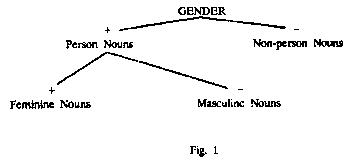
27
The strong member of the lower opposition is the feminine subclass of person nouns, its sememic mark
being "female sex". Here , belong such nouns as woman, girl, mother, bride, etc. The masculine subclass of
person nouns comprising such words as man, boy, father, bridegroom, etc. makes up the weak member of the
opposition.
The oppositional structure of the category of gender can be shown schematically on the following
diagramme (see Fig. 1).
A great many person nouns in English are capable of expressing both feminine and masculine person
genders by way of the pronominal correlation in question. These are referred to as nouns of the "common
gender". Here belong such words as person, parent, friend, cousin, doctor, president, etc. E.g.:
The President of our Medical Society isn't going to be happy about the suggested way of cure. In general
she insists on quite another kind of treatment in cases like that.
The capability of expressing both genders makes the gender distinctions in the nouns of the common gender
into a variable category. On the other hand, when there is no special need to indicate the sex of the person
referents of these nouns, they are used neutrally as masculine, i.e. they correlate with the masculine third person
pronoun.
In the plural, all the gender distinctions are neutralized in 'the immediate explicit expression, though they are
rendered obliquely through the correlation with the singular.
§ 3. Alongside the demonstrated grammatical (or lexico-grammatical, for that matter) gender distinctions,
English nouns can show the sex of their referents lexically, either by means of being combined with certain
notional words used as sex indicators, or else by suffixal derivation. Cf:. boy-friend, girl-friend; man-producer,
woman-producer; washer-man, washer-woman; landlord, landlady, bull-calf, cow-calf; cock-sparrow, hen-
sparrow; he-bear, she-bear; master, mistress; actor, actress; executor, executrix; lion, lioness; sultan, sultana;
etc.
One might think that this kind of the expression of sex runs contrary to the presented gender system of
nouns, since the sex distinctions inherent in the cited pairs of words refer not only to human beings (persons),
but also to all the other animate beings. On closer observation, however, we see that this is not at all so. In fact,
the referents of such nouns as jenny-ass, or pea-hen, or the like will in the common use quite naturally be
represented as it, the same as the referents of the corresponding masculine nouns jackass, pea-cock, and the
like. This kind of representation is different in principle from the corresponding representation of such nounal
pairs as woman - man, sister - brother, etc.
On the other hand, when the pronominal relation of the non-person animate nouns is turned, respectively,
into he and she, we can speak of a grammatical personifying transposition, very typical of English. This kind of
transposition affects not only animate nouns, but also a wide range of inanimate nouns, being regulated in
everyday language by cultural-historical traditions. Compare the reference of she with the names of countries,
vehicles, weaker animals, etc.; the reference of he with the names of stronger animals, the names of phenomena
suggesting crude strength and fierceness, etc.
§ 4. As we see, the category of gender in English is inherently semantic, i.e. meaningful in so far as it
reflects the actual features of the named objects. But the semantic nature of the category does not in the least
make it into "non-grammatical", which follows from the whole content of what has been said in the present
work.
In Russian, German, and many other languages characterized by the gender division of nouns, the gender
has purely formal features that may even "run contrary" to semantics. Suffice it to compare such Russian
words as стакан - он, чашка - она, блюдце - оно, as well as their German correspondences das Glas-es, die
Tasse-sie, der Teller-er, etc. But this phenomenon is rather an exception than the rule in terms of grammatical

